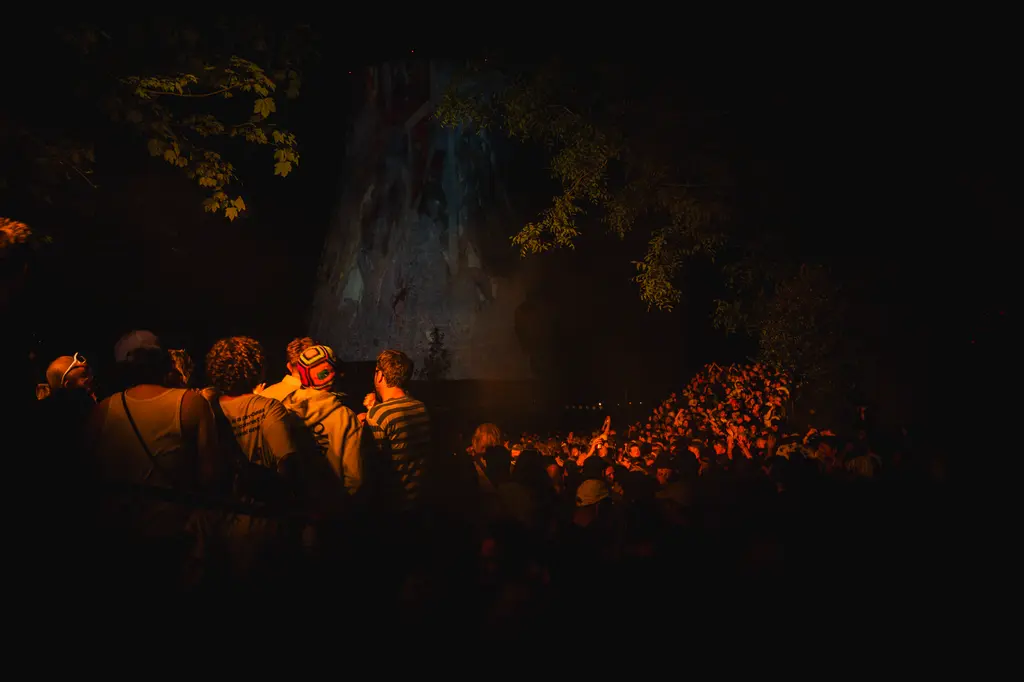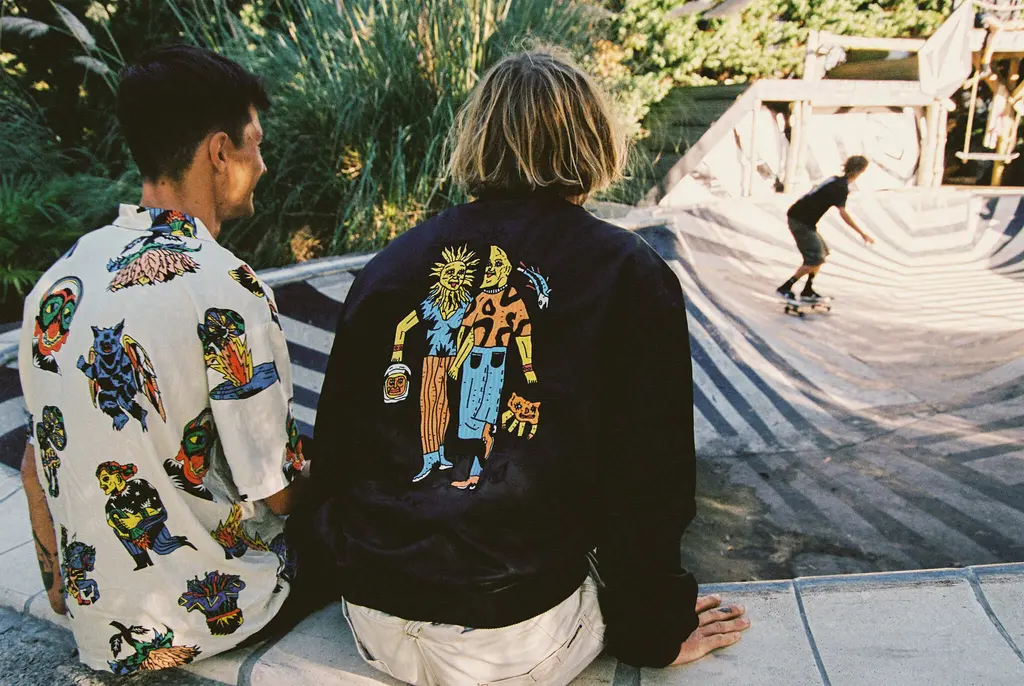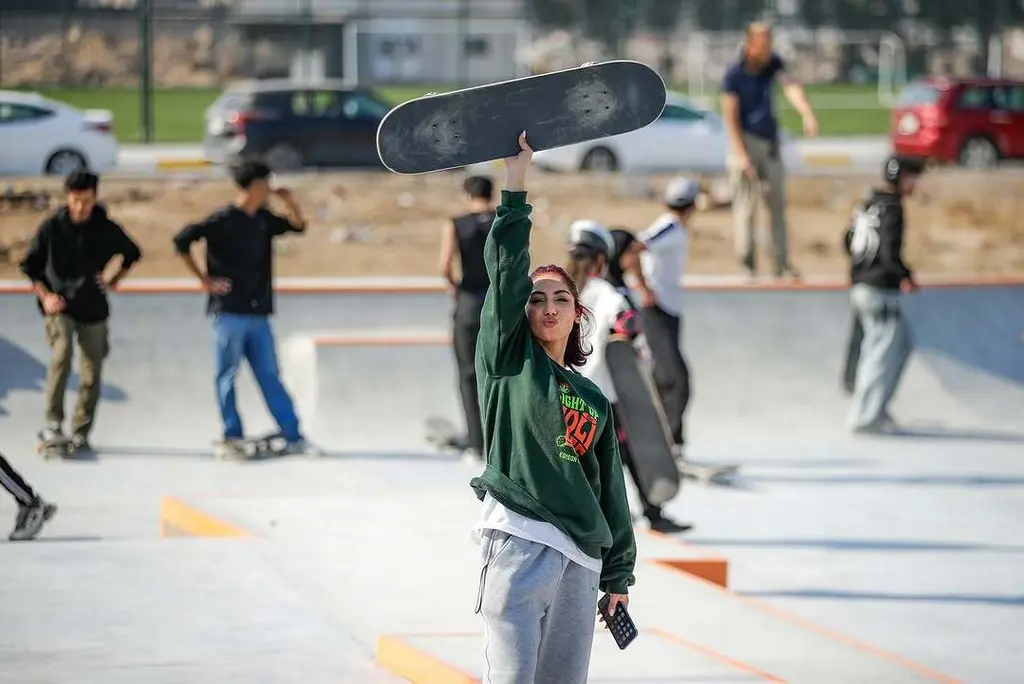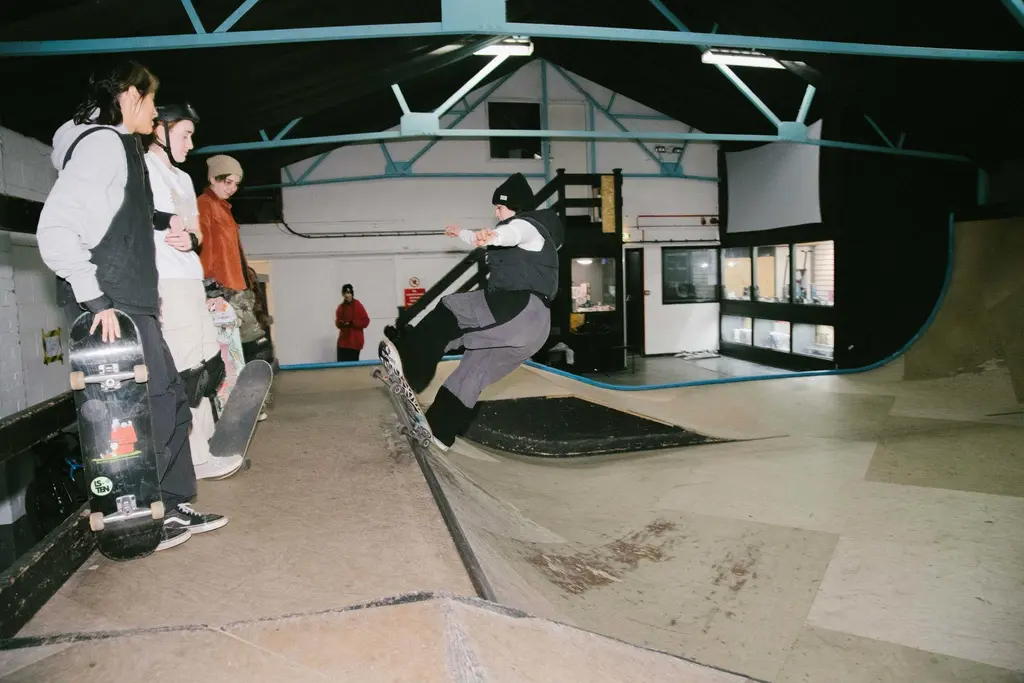Chuck Treece is kicking down doors, so others can roll through
- Text by Tracy Kawalik
- Photography by Kristin Chalmers

A version of this story appears in Issue 79 of Huck. Get your copy now, or subscribe to make sure you never miss another issue.
1984, USA. Vanessa Williams became the first African American crowned Miss America. Michael Jackson was the first solo artist to win eight Grammy’s in one night. And Chuck Treece, already the first Black skater from Philly to be sponsored, toasted his birthday month that year by becoming the first African American skateboarder on the cover of Thrasher Magazine. At the same time, his skate rock group McRad dropped their debut EP, Dominant Force — containing some of the most anthemic skate music ever written.
Fast forward to the present, and when we speak, one month away from Chuck’s 59th, he’s in his hotel room, on tour with Philly rockers G Love and fresh from an evening skate. It’s 3am in London and 8pm in Miami, but behind crystalline eyes, Chuck radiates an energy that transcends the late-night Zoom ultraviolets.
“You find energy when you use your body for the right things and do what you love to do,” he beams. “If my energy is running low five minutes before I get on stage and play, or even tonight when I went to skate, as soon as I put the board down or the music kicks in, it feels electric.”
Born in Newark, Delaware, on May 30, 1964, Chuck was raised on a diet of rhythm & blues, rock and roll, jazz and Parliament Funk, among other Black sounds. “I started banging on pots and pans at the age of two. At six, I had a drum kit. My father had a Top 40 cover band who I would jam with, playing drums, or goofing around on bass guitar. By eight, I was playing my first shows with them in Chester, PA at a bar called Boots and Bonnets. My dad took me to the side and said, ‘Chuck, you need to sit in tonight on two songs. You’ll get a drum solo’.
Not long after, Chuck discovered skating. “I was already playing baseball, so I was athletic,” he says. “But the minute I turned 11, I saw some kids skateboarding and it changed my life. I bought a $15 plastic board, went out there, scraped my knee, and I’ve been at it ever since.”
Chuck’s mom and dad split, and he began travelling back and forth between Philly and Delaware. “It was common back then for skaters to travel pretty far to skate their favourite parks. Skateboarding will always be a word- of-mouth family, so when you heard something was going on, you had to figure out how to get there,” he explains.
“I skated a bunch of parks with that rage-of-the-70s lifestyle. In the 1980s, skateboarding was super fun but raw at the same time… it wasn’t easy. Ramps would be found in all sorts of shapes back then. The state of skating was rapidly moving. Wheels were changing, boards, the scenes too — and the people were changing it heavily.”
Chuck navigated his way into the underground East Coast scene and carried that through into his music, defining his own style in his own way. “Music and skating happened simultaneously. Punk started showing up right when I was 13. All my friends were showing me this aggressive underground music they were into, which led me to punk rock and me forming the identity I have today. Skating and punk made the most sense to me. It felt like we were all growing up together at the same time.”
Chuck cut his skate chops shredding up infamous parks like Easy Ride, Cherry Hill and Webers Wave alongside skate legends (referred to decades later by New York Magazine as Dogtown East) like Tom Groholski, Steve Herring, Puppethead, Papa, and was one of the very few Black skaters he says that were “sprinkled here and there.”
“Freddie DeSoto was on Variflex, and I identified with him because he was also Black. I didn’t let that get to me when skating, but it was good to see those dudes around. Marty Grimes was the only other Black skateboarder that I knew about.”
Chuck was deep in the scene and becoming a pivotal force himself. At 14 years old, he wrote a letter expressing his passion for skate culture and thirst for knowledge to one of his heaviest inspirations; Stacy Peralta. “I started getting into magazines because guys in my local park were cranking airs and doing handplants. I’d read other interviews with Peter Griffin and Rick Blackhart, and they were cool, but for some reason, Stacy put it down right. It totally opened my mind. I was so stoked on his interview.”
Peralta, a former Z‑Boy, had become the highest-ranked professional skateboarder aged 19 and joined forces with manufacturer George Powell to form Powell-Peralta, which would grow to be one of the most successful skateboard brands of the 1980s. With the cash from Powell-Peralta, he formed the seminal Bones Brigade, a team composed of some of the best skaters at the time, many of whom revolutionised modern skateboarding. Peralta would later make cult documentary, Dogtown and Z‑Boys, and write Lords of Dogtown, among many other projects.
“I wrote Stacy Peralta a letter. He actually wrote me back — in his own handwriting. I was totally blown away. It was great for someone my age. I was humbled that he was writing to me and that he was filling me with information on a scene that I was just starting to get into, let alone being accepted into. He was the first West Coast guy to say, ‘Yeah, we’ve got stuff going on out here, but you’ve got some amazing guys in your area,’ dropping names like Jamie Godfrey and Mike Jesilowski.
"I bought a $15 board, scraped my knee and I've been at it ever since" Chuck Treece

Once I met those guys, I knew what to expect. The first time I saw Mike, he was doing board slides more than halfway around the egg bowl.”
Chuck knew he had to keep up the pace to lock down his future. “I remember asking my history teacher in grade 11, ‘What is fear?’ He was like, ‘Why are you asking me that?’ and I said, ‘Well, I have all my skateboard tricks written down on this paper here, and I know that one day I want to be sponsored, but I know that I’ll have to get through about 15 of these tricks first so that I can feel that I’m good enough to represent a company and good enough to make a name for myself. He looked at me and said, ‘Fear is something that you set up within yourself, you can conquer. When he asked me what I was trying to conquer, I said ‘I want to go out and showcase this art form of skateboarding to the world.”
In 1982, Chuck became a professional skater, going on to be sponsored by Santa Cruz Skateboards, Powell-Peralta, and Airwalk. “I was sick of high school and I knew I wasn’t going to college. All I wanted to do was music and skate.” Chuck laughs. By the end of that year, he, and fellow skater Zeke Zagar, decided to start a band positioned around skateboarding and Afro-punk. McRad was comprised of Chuck (the oldest at 19) and a group of skate rockers aged 14 – 16. Within six weeks, they were playing shows and opening for bands like DC hardcore group Minor Threat.
In 1984, Chuck moved to San Francisco on a meteoric trajectory through both worlds. “Tom Groholski and I created this new backyard skate scene at the time, and Glen Friedman showed up to have a photo session. We all loved Glen; he was an iconic photographer. So when somebody shows up who has been around cats like Jay Adams and Stacy, you want to push to do your best. He saw me doing that layback rollout, and he was like, “Do you mind doing that about 30 times, I think we have something”, Chuck blushes. “It was weird because the ramp was only 12ft wide, 11ft high! So Glen was literally standing about 3ft away from me. I’m sliding into his face every time he takes the shot. It was cool.”
The late Fausto Vitello, a co-founder of Thrasher, broke the cover news. “God rest Fausto’s soul; he was more or less the apex of Thrasher.” Chuck respectfully states, “I called him, and I was like ‘Tom and I have this whole double thing where I’m laying back and my head’s going over the top of the ramp, and Tom’s doing an invert over me. Is that in there?’ He goes, ‘yeah, it’s in there, but you got the front cover.’ At that point, I was blown away. I was this unknown skateboarder from Philadelphia. I was a gritty kid who lived on my skateboard. I just loved skating, going to shows and seeing my friends. I wasn’t expecting where it all would take me.”


“1984 was such a fun year. It’s the year I wrote ‘Weakness’ and ‘McShred’ in West Philly and San Francisco. People started to notice what I was doing and other folks offered overall vibes.” Chuck smiles.
By 1986, Chuck was travelling non-stop, meeting friends, skateboarding, playing shows and had his focus locked on songwriting and studio session work. “At that time, for music, we didn’t have the internet. So we were always playing out live at skate parks, DIY shows, and making fanzines.” Peralta invited Treece and McRad to do music for seminal skate videos Ban This, Propaganda, and Public Domain. The latter being a street-skate sensation that gave the band major exposure, featuring ‘Weakness’ and ‘McShred’ played over black-and-white footage of teen prodigies Ray Barbee, Steve Saiz, and Eric Sanderson ollieing down staircases and over fire hydrants.
After that, Treece was in demand and being poached to play with bands such as New York hardcore bands Underdog, Urge to Kill and the mother of all Black hard-rock bands, Bad Brains. “‘PMA’ by Bad Brains is my favourite song to skate to,” he says. “We played that constantly growing up skating. When I hear that, I have to grab my board. That first Bad Brains cassette is just so epic. If you can’t get energy from that when you’re doing something physical, then there’s something wrong with you!” Chuck winks.
McRad had opened for H.R. of Bad Brains and Chuck had already struck a friendship, but when Dr Know, Darryl Jennifer and the rest of the band approached him to join the band, that was the pinnacle. “For me, that was like my ultimate goal of drumming, and to say to myself, “OK, now put your skills to the test” Bad Brains’ music is probably some of the hardest music to play and keep your tenacity up. We were doing 30-night tours, 28 shows, one of the days off, and one was a travel day. So you’re talking 2.5 hours every night, 25 songs. I used to have to stick my hands in bowls of ice just so that they wouldn’t blow up.”
He later played on albums with The Roots, Jazzy Jeff, Bedouin Soundclash, and Schoolly D, played bass on Billy Joel’s ‘River of Dreams’, and played drums for Pearl Jam on one memorable live show. “My proudest achievement out of all of this,” he says, “is meeting some of the most talented and coolest people in the world. Most of my favourite musicians today are people who skate. I can tell straight away if I meet a musician and they’re a skater. It’s just their attitude and the way that they carry themselves. They’ll get in the car and drive 14 hours for a gig because they had to do that with skating. Or we’ll be the people who crash on a couch if it still means we can go play the gig, we don’t care. We don’t let anything stand in our way.”
Throughout his life, Chuck has continually elevated those around him. One artist in particular was Santigold. A young Santi White started her punk band, Stiffed, in 2002 with Chuck on drums and a vision for her to write songs behind the scenes. But Chuck encouraged her to step up to the mic. Today, Santigold credits him with being the man who got her to sing. “Santi paid her dues. She is one of the only people I’ve seen start out fronting a punk band and really take it to that level. I had her play some raw shows and she had never been used to that. The punk rock massive saw her talent and everyone started gravitating to her through that from skateboarding, underground culture, punk ethos. So when she invited me back to play on the first record Santogold, it just took off. Then it was rad to play with her on [NPR’s] Tiny Desk Concert and toast her 2022 album Spirituals.”
When asked how music has impacted his skating and vice versa, Chuck replies: “the element of music that’s helped my skating is taking something basic and building on it. If I want to learn a song, I can just learn a piece of it. It might not be the whole thing, but when that part comes around you can play it. The same thing with skating. If I want to learn a trick, I’ll go learn it on the curb or a small ramp first and then take it to a bigger ramp. So it was the influence of starting small and taking it into something bigger.”
Between skating and sessioning, it’s no surprise Chuck failed to notice he’d made history along the way. “Someone actually had to tell me way later that my Thrasher cover was the first cover with a Black skater. I wasn’t even concerned about being Black at the time. It was hard enough just being a skateboarder. I was happy Tom Groholski’s backyard ramp was getting exposure. Then, about 20 years later, I realised it at this event in LA called As We Roll, which was an event honouring ethnic skateboarders and their impact on the culture.”
Chuck has championed the evolution of the skate scene and rode it out at every twist and turn as more and more skateparks closed due to liability issues. “I remember once the 70s wave of skateboarding kinda died out it seemed that a lot of the skaters I looked up to left — and not like those guys didn’t want to rebuild it — but I just don’t really know if they knew how to acclimate themselves into skating without being able to go to skateparks. But I was skateboarding, and I felt like ‘something needs to change about it. We need to integrate it into the cities. It’s not just a suburban thing, it’s not just a surf thing, it’s this whole worldly thing.’


“At first, when the change happened it wasn’t for everyone. You had to learn how to street skate and just travel blocks and blocks to find the right spot where you’d go, “Right, let’s skate it.” Before it’d be, “Fuck, the cops are coming” or a security guard was running towards you. Skateboarding at that time was completely rebuilding itself. As a business, as a lifestyle, as everything. Now it feels like it’s all one thing again. Now there are skateparks in the Hills, there are 300 skate parks in Colorado alone and cool architecture all over for cats to street skate,” Chuck concludes.
Off the street, Chuck has helped reopen, rebuild, and keep skateparks alive. “There are a bunch of charity things I’ve done. Whenever somebody needed to lobby for a park, I would show up with my son and we would skate or play live and we just kept doing that. For some reason that just started to spark.” Outside of saving skateparks, Chuck was approached by a fellow skater to get involved on a compilation for The Brendan Borek Foundation for Cancer in Avalon, New Jersey for a young skater who passed away. Not only did Chuck agree, he brought Bad Brains back together with Chino Moreno of Deftones.
In 2010, Chuck was awarded a Pew Fellowships in the Arts grant. He’s had a lengthy list of boards made in his honour, Speedlab Wheels put out a McRad Weakness Wheel and in 2010, Nike SB celebrated Black History Month with The ‘McRad’ Dunk Hi Pro. Chuck helped design the sneakers and the colourway was inspired by his Thrasher cover.
Now skateboarding is in the Summer Olympic Games. “We as skaters still feel like the X Games is the crème de la crème because it’s so connected to what we’re doing,” he says. “But I feel like with the Olympics it’s going to give skating another place for people and parents to get into it, who may not know how to get into the lifestyle. The Olympics gives them that chance to be athletes. It’s not just basketball or baseball anymore, young kids will be on TV inspiring other kids to skate all over the world.”
The sun’s coming up in London but the night’s still young in Miami. Chuck ends our chat by saying, “skateboarding and music are one for me; once skating came along it just made sense to have access to both. I want to ride skating and music off into the clouds, staying on the ride as long as possible.”
Enjoyed this article? Follow Huck on Twitter and Instagram.
You might like

“Moment of escape”: Maen Hammad’s defiant West Bank skate photos
Landing — Choosing to return to Palestine after growing up in the USA, the photographer found himself drawn to Ramallah’s burgeoning skate scene. His debut monograph explores the city’s rebellious youth, who pull tricks in the face of occupation.
Written by: Miss Rosen

The Ukrainian skatepark sanctuary on the frontlines of war
Krytka — In Okhtyrka, just 50km from the border with Russia, a crew of young skaters, musicians and friends gutted out an abandoned factory, filling it with ramps and music equipment to create a shelter of community and resilience.
Written by: Isaac Muk

At Belgium’s Horst, electronic music, skate and community collide
More than a festival — With art exhibitions, youth projects and a brand new skatepark, the Vilvoorde-Brussels weekender is demonstrating how music events can have an impact all year round.
Written by: Isaac Muk

Volcom teams up with Bob Mollema for the latest in its Featured Artist Series
True to This — The boardsports lifestyle brand will host an art show in Biarritz to celebrate the Dutch illustrators’ second capsule collection.
Written by: Huck

In Baghdad, skater girls are reshaping Iraqi womanhood
Baghdad is rad — As the city’s first skatepark opens, the new space is providing a blank canvas for its board culture. Dalia Dawood speaks to the people looking to make its ramps and rails a safe haven for women and girls.
Written by: Dalia Dawood

In England’s rural north, skateboarding is femme
Zine scene — A new project from visual artist Juliet Klottrup, ‘Skate Like a Lass’, spotlights the FLINTA+ collectives who are redefining what it means to be a skater.
Written by: Zahra Onsori

